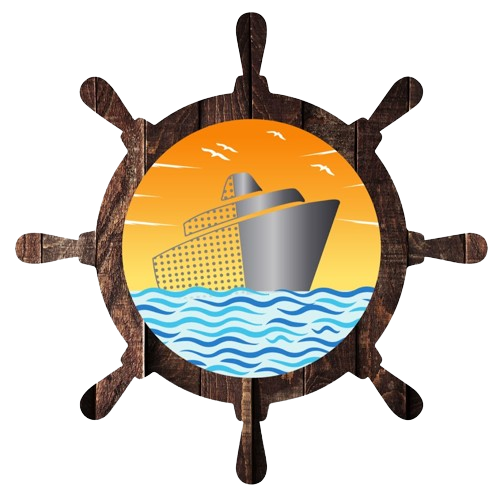What is the stern of the ship?
The stern is a ship’s backward or aft-most part and an important structural and functional element.
The stern improves the ship’s performance, stability, and maneuverability. It often houses essential components such as the rudder, which steers the boat, and the propellers, which provide propulsion.
The design of the stern has evolved, with modern vessels incorporating streamlined shapes to reduce water resistance and improve fuel efficiency.
On passenger ships, the stern has recreational spaces, and on cargo or naval ships, it supports operational functions such as cargo handling or weapon systems.
The stern’s importance is beyond functionality, it often bears the ship’s name and port of registry, symbolizing its identity and origin.
A well-designed stern ensures the vessel’s overall performance and operational efficiency.
What are the Different Types of Sterns?
There are mainly three types of stern:
- Elliptical Stern
- Cruiser Stern
- Transom Stern
Elliptical Stern
Merchant sterns, elliptical sterns, were common designs for cargo ships in the early 20th century. When viewed from the side, their deck line and knuckle line look approximately elliptical.
Counter sterns, also known as cutaway sterns, have an upwardly curved profile starting ahead of the aft perpendicular, resembling cruiser sterns. However, unlike cruiser sterns, the rudder cutaway in counter sterns is located above the waterline, resulting in a noticeable aft overhang and an exposed skeg.
The elliptical stern, a hallmark of traditional ship design during the early 20th century, is characterized by its rounded, smooth, and aesthetically graceful shape.
When viewed from above, the deck line and the knuckle line trace an elliptical curve, giving the stern its distinct name.
This design was very popular for cargo ships and passenger liners for its elegant appearance and functional benefits.
Its curvature allows for better water flow around the hull compared to square sterns, improving hydrodynamic efficiency and reducing resistance.
The elliptical stern is a symbol of classical ship aesthetics and functionality in maritime history.
Cruiser Stern
The cruiser stern was originally developed to position the steering gear beneath the armor deck.
It features a profile that is upwardly curved extending from the aft perpendicular to the main deck or poop deck.
The rudder cutaway in a cruiser stern is located below the waterline which ensures the rudder remains fully submerged at the designed waterline. Cruiser sterns offer superior resistance characteristics compared to merchant sterns.
The length of the waterplane and the cruise stern is more than the length between perpendiculars. This stern design is not only hydrodynamically efficient but also provides a more visually appealing profile.
The cruiser stern represents a significant evolution in ship design, combining functionality, hydrodynamic efficiency, and aesthetics. Its defining feature is the upwardly curved profile extending from the aft perpendicular to the main or poop deck, providing a streamlined and elegant appearance. Initially designed to lower the steering gear beneath the armor deck on naval ships, the cruiser stern quickly gained popularity for its practical and performance-related benefits.
One of the standout features of the cruiser stern is the positioning of the rudder cutaway below the waterline. This fully submerges the rudder at the design waterline, resulting in improved steering efficiency and reduced turbulence around the stern. The design contributes to superior resistance characteristics compared to older stern types like the merchant or counter stern, as it allows smoother water flow, minimizing drag and enhancing fuel efficiency.
The cruiser stern also extends the length of the waterplane beyond the length between perpendiculars (Lpp), improving buoyancy and stability. Its hydrodynamic advantages make it particularly suitable for vessels requiring efficient propulsion and maneuverability, such as warships, passenger liners, and modern cargo ships.
Beyond its technical benefits, the cruiser stern’s graceful curves contribute to an aesthetically pleasing silhouette, making it a popular choice for shipowners who value both performance and visual appeal. Despite the advent of transom sterns in later designs, the cruiser stern remains a classic symbol of maritime engineering and elegance.
Transom Stern
A transom stern is defined by its flat, broad shape that extends down to the waterline. This design provides a larger aft deck area, simplifies construction, and enhances water flow around the stern. Essentially, a transom stern can be seen as a cruiser stern with the aft-most section truncated.
The transom stern is a modern and widely used stern design, particularly favored for its practicality, efficiency, and versatility.
Its defining feature is a flat, broad surface at the aft, which extends down to or just above the waterline, creating a clean and functional shape. This stern type evolved as a response to the need for greater deck space, ease of construction, and improved hydrodynamic performance.
The flat and wide design of the transom stern provides a larger working area at the aft. This additional space is highly beneficial for activities like cargo handling, equipment storage, or passenger amenities, depending on the vessel type.
The straightforward geometry of the transom stern simplifies shipbuilding processes, making it more cost-effective and reducing construction time. This simplicity also contributes to easier maintenance and repairs.
While the transom stern does not offer the same degree of streamlined flow as the cruiser stern, its design minimizes turbulence and improves water flow in modern high-speed vessels. Proper shaping of the transom area can significantly enhance propulsion efficiency, especially in vessels with twin or multiple propellers.
What are the functions of the stern?
The stern of a ship is important because of the following reasons:
- Propulsion: The stern houses the ship’s rudder and propeller, essential for controlling its movement and direction.
- Stability: The design of the stern plays a key role in determining the ship’s overall stability.
- Efficiency: The shape and structure of the stern significantly influence the vessel’s fuel efficiency.
- Maneuverability: A ship’s stern highly affects the maneuverability of the ship.
- Water Leakage Prevention: The stern tube is essential for preventing the leakage of water and oil between the ship and the sea.
- Connectivity: Mooring equipment and towing points are located at the stern, facilitating essential ship connections.
- Securing Sails: Cleats and chocks at the stern are used for securing sails effectively.
- Watersports: The stern is equipped with hardware for attaching lines and gear used in watersports activities.
- The Stern of a Ship: It is a portal to Maritime Heritage and Functionality.
What is a Stern Tube of a ship?
A ship’s stern tube is a hollow structure fixed at the aft of the ship that links the propeller shaft to the engine.
It serves as a passage for the propeller shaft to pass through the hull of the ship and extends into the engine room.
The stern tube is a critical component in a ship’s propulsion system. Its primary purpose is to provide a secure and watertight enclosure for the propeller shaft, enabling smooth transmission of power from the engine to the propeller while preventing water from entering the vessel.
It also houses key elements such as bearings, seals, and lubricants that ensure the efficient operation of the shaft.
The design and maintenance of the stern tube are essential for the vessel’s overall performance, as it impacts propulsion efficiency, safety, and reliability.
By minimizing friction and safeguarding against leaks, the stern tube plays a pivotal role in the smooth functioning of a ship’s propulsion system.
FAQs
Q1. What is the aft and stern?
Ans: Aft is the inner rearmost part of the ship and stern is the outer rearmost part of the ship.
Q2. What are the four sides of the ship called?
Ans: The four sides are bow, stern, port, starboard.
Q3. Why is stern important?
Ans: Stern is important for a ship’s stability, maneuverability, and for managing speed.
Q4. What is the main function of the stern?
Ans: The main function of the stern is to make space for steering devices.
Q5.What is a stern tube?
Ans: It is a hollow tube that runs through the stern of the ship and supports the propeller.
Disclaimer :- The opinions expressed in this article belong solely to the author and may not necessarily reflect those of Merchant Navy Decoded. We cannot guarantee the accuracy of the information provided and disclaim any responsibility for it. Data and visuals used are sourced from publicly available information and may not be authenticated by any regulatory body. Reviews and comments appearing on our blogs represent the opinions of individuals and do not necessarily reflect the views of Merchant Navy Decoded. We are not responsible for any loss or damage resulting from reliance on these reviews or comments.
Reproduction, copying, sharing, or use of the article or images in any form is strictly prohibited without prior permission from both the author and Merchant Navy Decoded.


